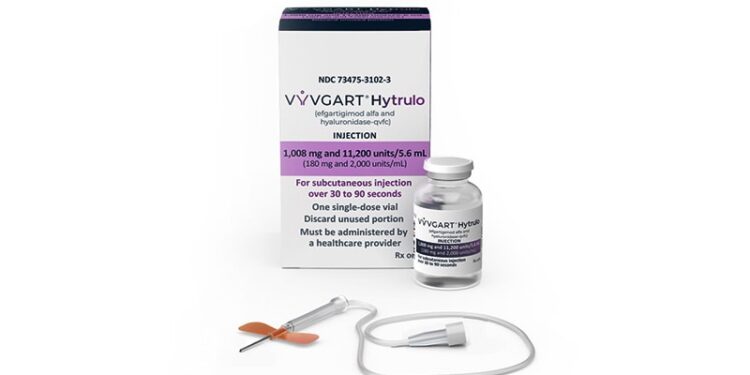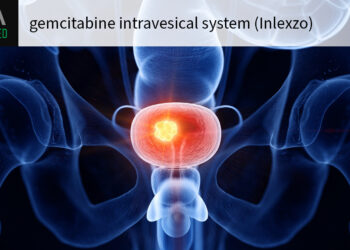BARCELONA, Spain — Efgartigimod could have a role to play in the treatment of both myositis and Sjögren disease, according to data from two “proof-of-concept” phase 2 studies reported at the European Alliance of Associations for Rheumatology (EULAR) 2025 Annual Meeting.
In the ALKIVIA study, involving 89 adults with active idiopathic inflammatory myopathy (IMM), significantly greater clinical improvement in muscle strength and physical function — as measured by the 2016 American College of Rheumatology (ACR)/EULAR Myositis Response Criteria’s Total Improvement Score (TIS) — was achieved with efgartigimod than with placebo.
The least-squares mean TIS at week 24 was 50.45 in the efgartigimod arm vs 35.65 in the placebo arm (P = .0004). There was also a significant improvement in mean TIS over time.
In the RHO study, a significantly greater proportion of the 23 adults with primary Sjögren disease treated with efgartigimod achieved the trial’s primary endpoint — a clinical response in at least three of five items using the Composite of Relevant Endpoints for Sjögren’s Syndrome (CRESS) measure — than did the 11 adults given a placebo.
At week 24, 45.5% of efgartigimod-treated individuals vs 11.1% of the placebo-treated participants met this primary endpoint of the trial.
Addressing Unmet Needs
IMM and Sjögren disease are two rheumatic and musculoskeletal diseases lacking effective treatments; targeting Immunoglobulin G (IgG) autoantibodies with efgartigimod was of interest, said both of the presenting investigators for the two studies at the meeting.

Hector Chinoy, MD, a consultant rheumatologist for Salford Royal Hospital and professor of rheumatology and neuromuscular disease at the University of Manchester, England, said during his presentation of the ALKIVIA study findings that, with regard to IMM, “We use too [many] steroids. We need a steroid-sparing profile, one providing a sustained response for both muscle and extra muscular involvement.”
Isabelle Peene, MD, of Ghent University Hospital and the VIB Center for Inflammation Research, both in Ghent, Belgium, said in her presentation of the RHO study data: “The most prominent autoantibodies in Sjögren’s are, of course, those against Rho52, Rho60, and SSB. As there is a high unmet need in Sjögren’s, we wondered whether the mode of action of efgartigimod could alter this disease course.”
Blocking Antibody Recycling
The data from the two studies looked “very promising,” Elizabeth Price, MBBCh, PhD, a consultant rheumatologist who works at Great Western Hospitals NHS Foundation Trust, Swindon, England, told Medscape Medical News.
Price, who has a specialist interest in Sjögren disease, said, “Efgartigimod is one of a new class of monoclonal antibodies targeting the [IgG1] neonatal Fc receptor [FcRn]. This receptor is involved in binding circulating immunoglobulins and transporting them across membranes (including the placenta).”
The drug, which had already gained regulatory approval in the US and some other countries for use in myasthenia gravis and chronic inflammatory demyelinating polyneuropathy, worked by reducing the level of IgG and other pathogenic autoantibodies.
By binding to FcRn, efgartigimod essentially blocked the ability for IgG to be recycled back into the circulation, and thus IgG levels were reduced without having an impact on antibody production in general, it was reported.
The ALKIVIA Study
ALKIVIA was an ongoing trial, Chinoy explained; a 52-week phase 3 component was continuing from the phase 2 results he presented.
The trial recruited people with several subtypes of IMM, including dermatomyositis, immune-mediated necrotizing myositis, polymyositis, or antisynthetase syndrome.
Participants were randomly allocated 1:1 to treatment with efgartigimod or placebo in addition to background IMM treatment. Those in the efgartigimod arm received a 1000 mg dose given subcutaneously once a week.
Baseline characteristics reflected “a typical profile of a myositis patient,” Chinoy said, and generally were comparable between the groups. Overall, the mean age was 56.6 years, and the median time since diagnosis was 4.4 years. Just over 75% were women, and 72% were White.
Chinoy noted that, in addition to higher TIS in the efgartigimod vs the placebo arm after 24 weeks, significantly more participants taking efgartigimod achieved TIS improvements of ≥ 20 (91.5% vs 73.8%, P = .025), ≥ 40 (78.7% vs 47.6%, P = .0029), and ≥ 60 (34.0% vs 9.5%, P = .0055), signifying mild, moderate, or major clinical improvement, respectively.
Clinical improvement occurred more quickly in the efgartigimod than in the placebo arm, with minimal improvement seen at a respective 30 vs 72 days (P = .002) and moderate improvement after 113 days vs not estimable (P = .029).
As for safety, similar percentages of efgartigimod-treated (87%) and placebo-allocated (88%) participants experienced at least one adverse event. Most adverse events occurring with efgartigimod were related to its mode of administration, with injection site bruising, redness, pain, or other reactions recorded.
There were fewer grade 3 or higher adverse events in the efgartigimod arm than in the placebo arm (14.9% vs 28.6%). Two deaths occurred with efgartigimod but none with placebo. Neither death was attributed to the drug; one involved a road traffic accident and the other was a case of preexisting liver cirrhosis that had “only really come to light during the course of the study,” said Chinoy.
Questioning the Data
Ronald van Vollenhoven, MD, PhD, of Amsterdam UMC and Amsterdam Rheumatology and Immunology Center ARC, Netherlands, said after Chinoy’s presentation that “this approach of lowering total IgG is very interesting.” He questioned, however, whether the drug could actually be targeting pathogenic antibodies vs endogenous immunoglobulins, “which obviously serve a useful purpose.”
Richard Alan Furie, MD, of Northwell Health in New York, New York, said he thought problems with placebo response rates had been seen in lupus, and he asked, “What do you think the reasons are for high placebo response rates in myositis, and what is being done about it?”
Chinoy responded: “Patients were allowed to be on background treatment; they could be on up to 20 mg of prednisolone at inclusion into the study.”
The baseline data showed that 82.0% had been treated with systemic corticosteroids, and more than three-quarters had received disease-modifying antirheumatic drugs.
This background treatment, along with some geographical variation that was noted in the TIS responses, was probably behind the high placebo response rate, Chinoy said.
“I think for future trials, we may be looking for a more stringent endpoint, for primary endpoints,” he added.
The RHO Study
The design of the RHO study was slightly different. It was a phase 2 study that was not designed to run directly into a phase 3 trial; randomization to efgartigimod or placebo was 2:1 rather than 1:1; and efgartigimod was given once weekly at a 10 mg/kg intravenous dose rather than subcutaneously.
Participants enrolled in the study had to meet the following criteria: a diagnosis of Sjögren disease as per ACR/EULAR 2016 criteria within the past 7 years, an EULAR Sjögren’s Syndrome Disease Activity Index (ESSDAI) ≥ 5, positive test for anti-Ro/SS-A antibodies, and residual salivary flow.
Three of the 34 people who were randomized did not meet these eligibility criteria, however, and were not included in the efficacy analysis, Peene reported.
Although baseline demographic data were fairly typical for Sjögren disease — almost all participants were female — Peene acknowledged after questioning that there were some differences between the groups. For example, the median age was 49 years in the efgartigimod group and 58 years in the placebo group, and the median clinical ESSDAI scores were 13 vs 18.
“It’s a very small study,” Peene said. “We just wanted to have [an] idea of, is it working? And what’s the estimate of the treatment effect? But I agree that this is a little bit skewed.”
Alongside CRESS, another relatively new outcome measure was used, the Sjögren’s Tool for Assessing Response (STAR). Results showed that 54.5% of efgartigimod-treated vs 33.3% of placebo-allocated participants had a score of score ≥ 5, which was the threshold needed to be a responder.
No relevant changes in the EULAR Sjögren’s Syndrome Patient Reported Index score were observed. But there were improvements in clinical ESSDAI total scores (-7.0 vs -4.0), which will be the primary endpoint in the follow-up phase 3 trial called UNITY.
Efgartigimod was also shown to reduce mean levels of both IgG (by 58%) and anti-Ro52 autoantibodies (by 64%) vs baseline to week 4 onward. By comparison, IgG levels were more or less unchanged in the placebo arm, and anti-Ro52 autoantibodies had increased by just under 40% from baseline.
There were also reductions in rheumatoid factor and complement component 1q seen with efgartigimod but not placebo.
At least one adverse event occurred in 87% of participants taking efgartigimod and 64% of those given placebo. No grade 3 or higher or fatal adverse events were observed. One adverse event in the efgartigimod arm led to discontinuation, but this was not related to the study drug, Peene said.
The most common adverse events — which occurred more often in the efgartigimod than in the placebo arm — were headache (17% vs 9%), nasopharyngitis (17% vs 9%), influenza (13% vs 0%), and urinary tract infection (13% vs 9%).
Promising Results, but More Data Required
Both the RHO and ALKIVIA studies were picked by Helga Lechner-Radner as part of her clinical highlights of the meeting.
During the EULAR 2025 Highlights session, Lechner-Radner, a senior physician at the Medical University of Vienna, Austria, said: “We need more data; the phase 3 [trials] of this compound [are] currently underway and we really look forward to [their results].”
The ALKIVIA and RHO studies were funded by argenx; study authors included employees of the company. Chinoy reported relationships with AstraZeneca, Pfizer, PTC Therapeutics, and UCB. Isabelle Peene acknowledged working with argenx and BMS. Bowman told Medscape Medical News he has been brought in as an independent consultant and was not an investigator for the UNITY study. Price, van Vollenhoven, and Furie had no relevant conflicts of interest to disclose.
Sara Freeman is a freelance medical journalist based in London, UK.
Source link : https://www.medscape.com/viewarticle/efgartigimod-use-extends-myositis-and-sj%C3%B6gren-disease-2025a1000hgh?src=rss
Author :
Publish date : 2025-06-30 19:58:00
Copyright for syndicated content belongs to the linked Source.












